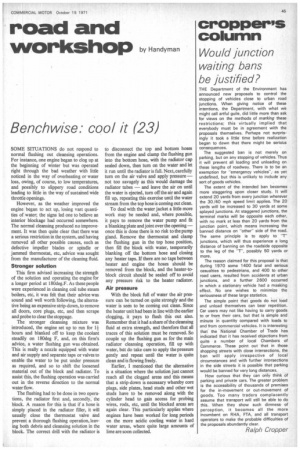cropper's column
Page 51

If you've noticed an error in this article please click here to report it so we can fix it.
Would junction waiting bans be justified?
THE Department of the Environment has announced new proposals to control the stopping of vehicles close to urban road junctions. When giving notice of these intentions, the Department, with what we might call artful guile, did little more than ask for views on the methods of marking these restrictions; this virtually implied that everybody must be in agreement with the proposals themselves. Perhaps not surprisingly it took a little time before realization began to dawn that there might be seriolis consequences.
The suggested ban is not merely on parking, but on any stopping of vehicles. Thus it will prevent all loading and unloading on these lengths of roadway. There is to be an exemption for "emergency vehicles", as yet undefined, but this is unlikely to include any sort of goods vehicles.
The extent of the intended ban becomes more staggering upon closer study. It will extend 20 yards from every junction wherever the 30/40 mph speed limit applies. The 20 yards will be increased to 30 yards at some splayed junctions. At staggered junctions, the terminal marks will be opposite each other, with no mark at less than 20 yards from the junction point, which means increasing the banned distance on "other" side of the road. The same principle is to apply to "T" junctions, which will thus experience a long distance of banning on the roadside opposite to the leg of the "T", possibly 50 yards or more.
The reason claimed for this proposal is that during 1970 some 1400 fatal and serious casualties to pedestrians, and 400 to other road users, resulted from accidents at urban junctions, and a further 2600 occurred in which a stationary vehicle had a masking effect. No one wishes to minimize the seriousness of these large statistics.
The simple point that goods do not load and unload themselves can bear repetition. Car users may not like having to carry goods to or from their cars, but that is simple and minute in quantity compared with loads to and from commercial vehicles. It is interesting that the National Chamber of Trade has indicated that it has received objections from quite a number of local Chambers of Commerce, These point out that in those shopping streets with close intersections, the ban will apply irrespective of local circumstances and with further intersections in the side streets it is possible that parking would be banned for very long distances.
How curious that they can only think of parking and private cars. The greater problem is the accessibility of thousands of premises for the in-movement or out-movement of goods. Too many traders complacently assume that transport will still be able to do this. When they show such dimness of perception, it becomes all the more incumbent on RHA, FTA, and all transport operators to make the probable difficulties of the proposals abundantly clear.
Ralph Cropper
















































































































